Design of Portal Frame Shades: A Comprehensive Overview and Analysis
VerifiedAdded on 2023/06/06
|6
|1457
|222
Report
AI Summary
This report provides a detailed analysis of portal frame shade design, focusing on steel structures commonly used in industrial buildings like warehouses. It begins with an introduction to portal frames, highlighting their use and construction with steel. The report then delves into a literature review, discussing the advantages of pre-engineered construction systems, including cost-effectiveness and shorter construction periods. It explores the use of software like STAAD Pro for structural analysis, covering parameters like bending moments and shear forces. The design of knee joints, critical for frame rigidity, is examined, along with recommendations for their construction. The report also addresses fire safety in steel portal frames, analyzing structural performance during fires and providing recommendations for column protection. Finally, serviceability limits, particularly deflection, are discussed, including the impact of Real-Coded Niching Genetic Algorithm (RC-NGA) in optimizing frame weight. The report concludes with a comprehensive set of references.
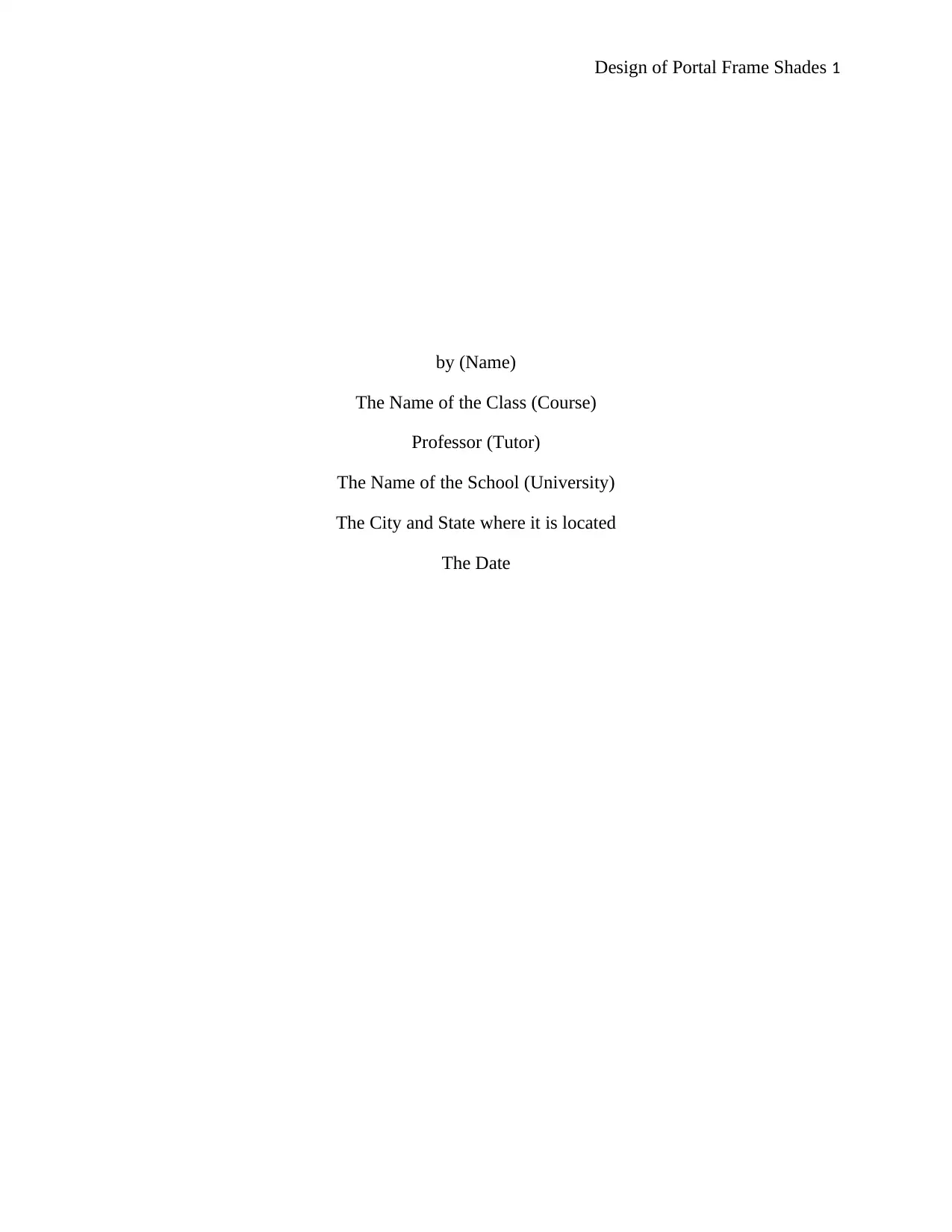
Design of Portal Frame Shades 1
by (Name)
The Name of the Class (Course)
Professor (Tutor)
The Name of the School (University)
The City and State where it is located
The Date
by (Name)
The Name of the Class (Course)
Professor (Tutor)
The Name of the School (University)
The City and State where it is located
The Date
Paraphrase This Document
Need a fresh take? Get an instant paraphrase of this document with our AI Paraphraser
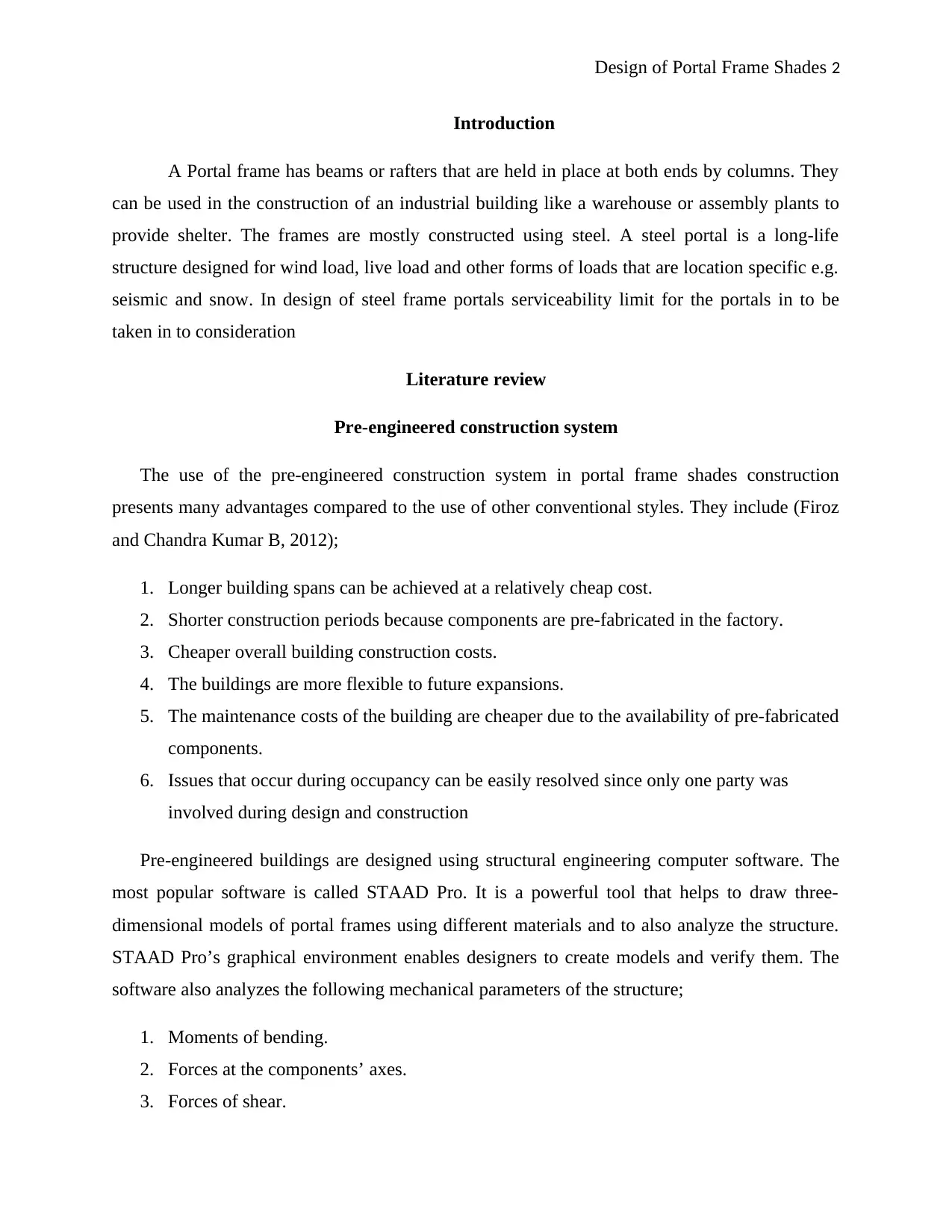
Design of Portal Frame Shades 2
Introduction
A Portal frame has beams or rafters that are held in place at both ends by columns. They
can be used in the construction of an industrial building like a warehouse or assembly plants to
provide shelter. The frames are mostly constructed using steel. A steel portal is a long-life
structure designed for wind load, live load and other forms of loads that are location specific e.g.
seismic and snow. In design of steel frame portals serviceability limit for the portals in to be
taken in to consideration
Literature review
Pre-engineered construction system
The use of the pre-engineered construction system in portal frame shades construction
presents many advantages compared to the use of other conventional styles. They include (Firoz
and Chandra Kumar B, 2012);
1. Longer building spans can be achieved at a relatively cheap cost.
2. Shorter construction periods because components are pre-fabricated in the factory.
3. Cheaper overall building construction costs.
4. The buildings are more flexible to future expansions.
5. The maintenance costs of the building are cheaper due to the availability of pre-fabricated
components.
6. Issues that occur during occupancy can be easily resolved since only one party was
involved during design and construction
Pre-engineered buildings are designed using structural engineering computer software. The
most popular software is called STAAD Pro. It is a powerful tool that helps to draw three-
dimensional models of portal frames using different materials and to also analyze the structure.
STAAD Pro’s graphical environment enables designers to create models and verify them. The
software also analyzes the following mechanical parameters of the structure;
1. Moments of bending.
2. Forces at the components’ axes.
3. Forces of shear.
Introduction
A Portal frame has beams or rafters that are held in place at both ends by columns. They
can be used in the construction of an industrial building like a warehouse or assembly plants to
provide shelter. The frames are mostly constructed using steel. A steel portal is a long-life
structure designed for wind load, live load and other forms of loads that are location specific e.g.
seismic and snow. In design of steel frame portals serviceability limit for the portals in to be
taken in to consideration
Literature review
Pre-engineered construction system
The use of the pre-engineered construction system in portal frame shades construction
presents many advantages compared to the use of other conventional styles. They include (Firoz
and Chandra Kumar B, 2012);
1. Longer building spans can be achieved at a relatively cheap cost.
2. Shorter construction periods because components are pre-fabricated in the factory.
3. Cheaper overall building construction costs.
4. The buildings are more flexible to future expansions.
5. The maintenance costs of the building are cheaper due to the availability of pre-fabricated
components.
6. Issues that occur during occupancy can be easily resolved since only one party was
involved during design and construction
Pre-engineered buildings are designed using structural engineering computer software. The
most popular software is called STAAD Pro. It is a powerful tool that helps to draw three-
dimensional models of portal frames using different materials and to also analyze the structure.
STAAD Pro’s graphical environment enables designers to create models and verify them. The
software also analyzes the following mechanical parameters of the structure;
1. Moments of bending.
2. Forces at the components’ axes.
3. Forces of shear.
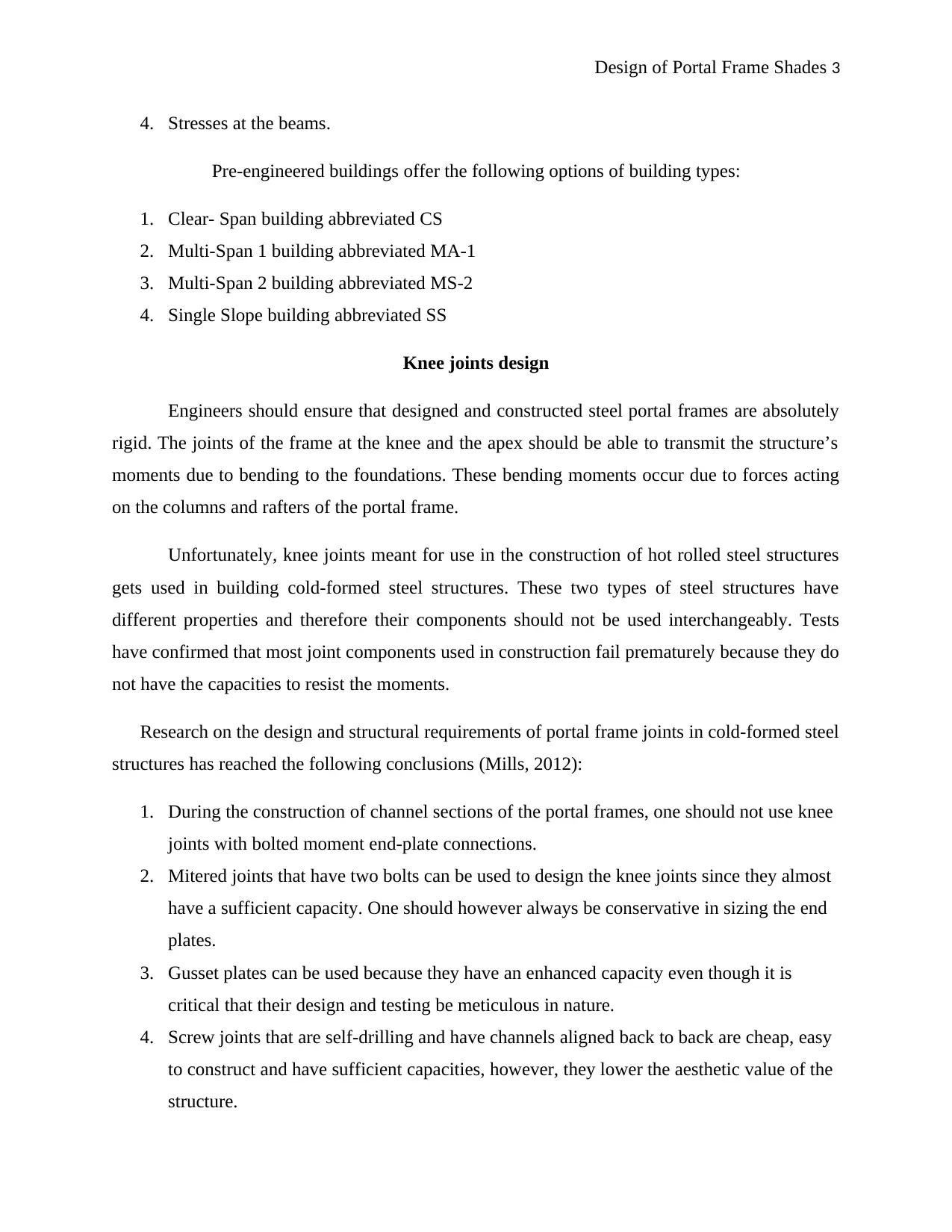
Design of Portal Frame Shades 3
4. Stresses at the beams.
Pre-engineered buildings offer the following options of building types:
1. Clear- Span building abbreviated CS
2. Multi-Span 1 building abbreviated MA-1
3. Multi-Span 2 building abbreviated MS-2
4. Single Slope building abbreviated SS
Knee joints design
Engineers should ensure that designed and constructed steel portal frames are absolutely
rigid. The joints of the frame at the knee and the apex should be able to transmit the structure’s
moments due to bending to the foundations. These bending moments occur due to forces acting
on the columns and rafters of the portal frame.
Unfortunately, knee joints meant for use in the construction of hot rolled steel structures
gets used in building cold-formed steel structures. These two types of steel structures have
different properties and therefore their components should not be used interchangeably. Tests
have confirmed that most joint components used in construction fail prematurely because they do
not have the capacities to resist the moments.
Research on the design and structural requirements of portal frame joints in cold-formed steel
structures has reached the following conclusions (Mills, 2012):
1. During the construction of channel sections of the portal frames, one should not use knee
joints with bolted moment end-plate connections.
2. Mitered joints that have two bolts can be used to design the knee joints since they almost
have a sufficient capacity. One should however always be conservative in sizing the end
plates.
3. Gusset plates can be used because they have an enhanced capacity even though it is
critical that their design and testing be meticulous in nature.
4. Screw joints that are self-drilling and have channels aligned back to back are cheap, easy
to construct and have sufficient capacities, however, they lower the aesthetic value of the
structure.
4. Stresses at the beams.
Pre-engineered buildings offer the following options of building types:
1. Clear- Span building abbreviated CS
2. Multi-Span 1 building abbreviated MA-1
3. Multi-Span 2 building abbreviated MS-2
4. Single Slope building abbreviated SS
Knee joints design
Engineers should ensure that designed and constructed steel portal frames are absolutely
rigid. The joints of the frame at the knee and the apex should be able to transmit the structure’s
moments due to bending to the foundations. These bending moments occur due to forces acting
on the columns and rafters of the portal frame.
Unfortunately, knee joints meant for use in the construction of hot rolled steel structures
gets used in building cold-formed steel structures. These two types of steel structures have
different properties and therefore their components should not be used interchangeably. Tests
have confirmed that most joint components used in construction fail prematurely because they do
not have the capacities to resist the moments.
Research on the design and structural requirements of portal frame joints in cold-formed steel
structures has reached the following conclusions (Mills, 2012):
1. During the construction of channel sections of the portal frames, one should not use knee
joints with bolted moment end-plate connections.
2. Mitered joints that have two bolts can be used to design the knee joints since they almost
have a sufficient capacity. One should however always be conservative in sizing the end
plates.
3. Gusset plates can be used because they have an enhanced capacity even though it is
critical that their design and testing be meticulous in nature.
4. Screw joints that are self-drilling and have channels aligned back to back are cheap, easy
to construct and have sufficient capacities, however, they lower the aesthetic value of the
structure.
⊘ This is a preview!⊘
Do you want full access?
Subscribe today to unlock all pages.

Trusted by 1+ million students worldwide
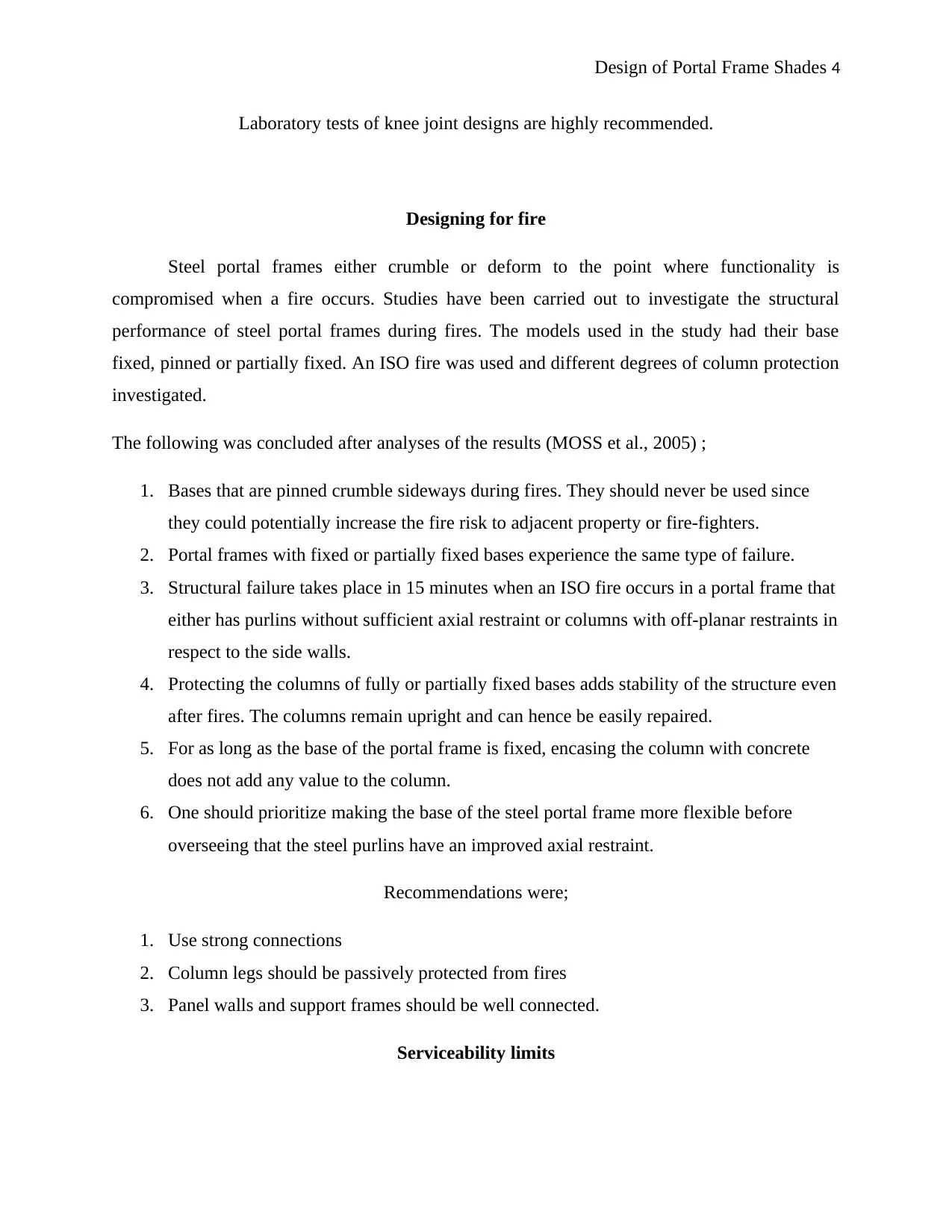
Design of Portal Frame Shades 4
Laboratory tests of knee joint designs are highly recommended.
Designing for fire
Steel portal frames either crumble or deform to the point where functionality is
compromised when a fire occurs. Studies have been carried out to investigate the structural
performance of steel portal frames during fires. The models used in the study had their base
fixed, pinned or partially fixed. An ISO fire was used and different degrees of column protection
investigated.
The following was concluded after analyses of the results (MOSS et al., 2005) ;
1. Bases that are pinned crumble sideways during fires. They should never be used since
they could potentially increase the fire risk to adjacent property or fire-fighters.
2. Portal frames with fixed or partially fixed bases experience the same type of failure.
3. Structural failure takes place in 15 minutes when an ISO fire occurs in a portal frame that
either has purlins without sufficient axial restraint or columns with off-planar restraints in
respect to the side walls.
4. Protecting the columns of fully or partially fixed bases adds stability of the structure even
after fires. The columns remain upright and can hence be easily repaired.
5. For as long as the base of the portal frame is fixed, encasing the column with concrete
does not add any value to the column.
6. One should prioritize making the base of the steel portal frame more flexible before
overseeing that the steel purlins have an improved axial restraint.
Recommendations were;
1. Use strong connections
2. Column legs should be passively protected from fires
3. Panel walls and support frames should be well connected.
Serviceability limits
Laboratory tests of knee joint designs are highly recommended.
Designing for fire
Steel portal frames either crumble or deform to the point where functionality is
compromised when a fire occurs. Studies have been carried out to investigate the structural
performance of steel portal frames during fires. The models used in the study had their base
fixed, pinned or partially fixed. An ISO fire was used and different degrees of column protection
investigated.
The following was concluded after analyses of the results (MOSS et al., 2005) ;
1. Bases that are pinned crumble sideways during fires. They should never be used since
they could potentially increase the fire risk to adjacent property or fire-fighters.
2. Portal frames with fixed or partially fixed bases experience the same type of failure.
3. Structural failure takes place in 15 minutes when an ISO fire occurs in a portal frame that
either has purlins without sufficient axial restraint or columns with off-planar restraints in
respect to the side walls.
4. Protecting the columns of fully or partially fixed bases adds stability of the structure even
after fires. The columns remain upright and can hence be easily repaired.
5. For as long as the base of the portal frame is fixed, encasing the column with concrete
does not add any value to the column.
6. One should prioritize making the base of the steel portal frame more flexible before
overseeing that the steel purlins have an improved axial restraint.
Recommendations were;
1. Use strong connections
2. Column legs should be passively protected from fires
3. Panel walls and support frames should be well connected.
Serviceability limits
Paraphrase This Document
Need a fresh take? Get an instant paraphrase of this document with our AI Paraphraser
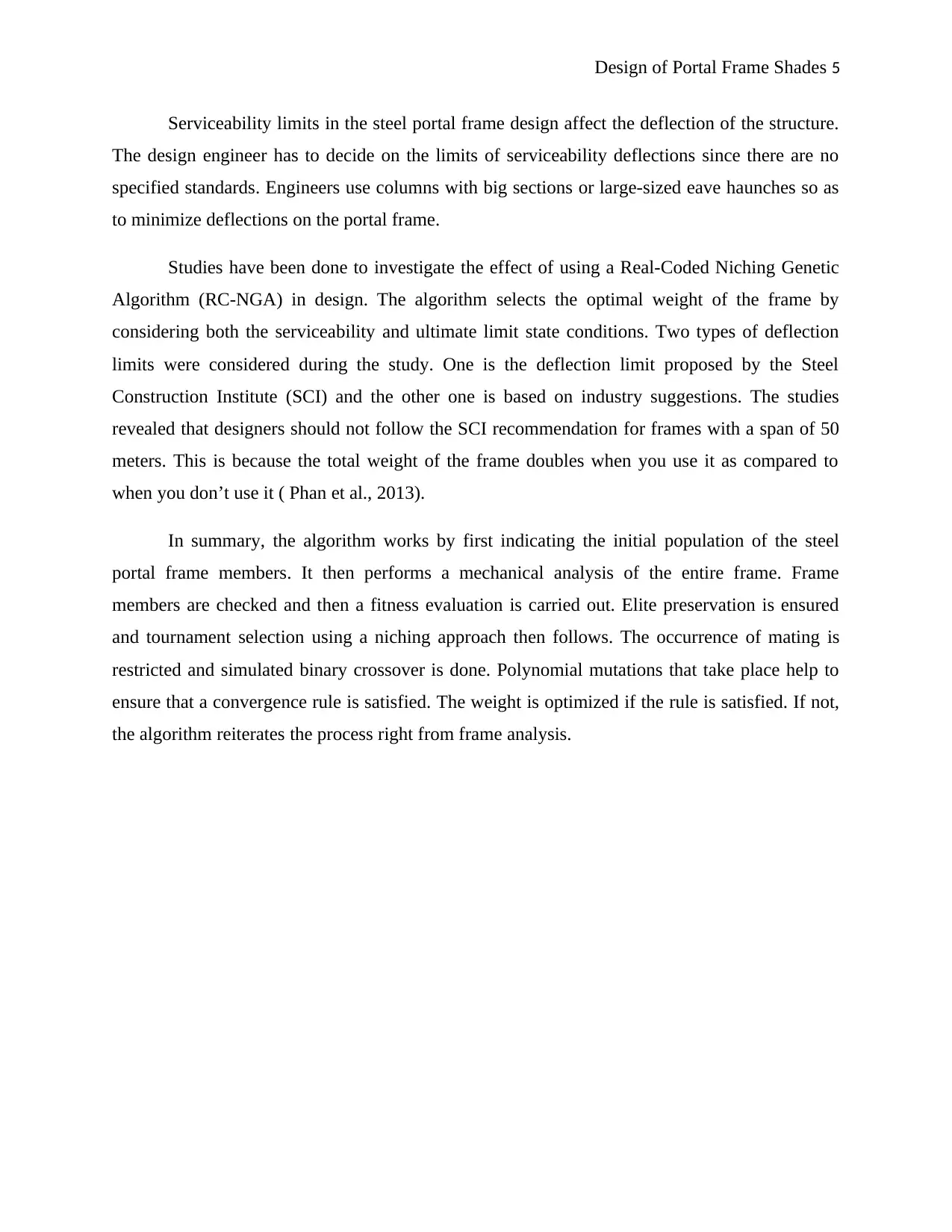
Design of Portal Frame Shades 5
Serviceability limits in the steel portal frame design affect the deflection of the structure.
The design engineer has to decide on the limits of serviceability deflections since there are no
specified standards. Engineers use columns with big sections or large-sized eave haunches so as
to minimize deflections on the portal frame.
Studies have been done to investigate the effect of using a Real-Coded Niching Genetic
Algorithm (RC-NGA) in design. The algorithm selects the optimal weight of the frame by
considering both the serviceability and ultimate limit state conditions. Two types of deflection
limits were considered during the study. One is the deflection limit proposed by the Steel
Construction Institute (SCI) and the other one is based on industry suggestions. The studies
revealed that designers should not follow the SCI recommendation for frames with a span of 50
meters. This is because the total weight of the frame doubles when you use it as compared to
when you don’t use it ( Phan et al., 2013).
In summary, the algorithm works by first indicating the initial population of the steel
portal frame members. It then performs a mechanical analysis of the entire frame. Frame
members are checked and then a fitness evaluation is carried out. Elite preservation is ensured
and tournament selection using a niching approach then follows. The occurrence of mating is
restricted and simulated binary crossover is done. Polynomial mutations that take place help to
ensure that a convergence rule is satisfied. The weight is optimized if the rule is satisfied. If not,
the algorithm reiterates the process right from frame analysis.
Serviceability limits in the steel portal frame design affect the deflection of the structure.
The design engineer has to decide on the limits of serviceability deflections since there are no
specified standards. Engineers use columns with big sections or large-sized eave haunches so as
to minimize deflections on the portal frame.
Studies have been done to investigate the effect of using a Real-Coded Niching Genetic
Algorithm (RC-NGA) in design. The algorithm selects the optimal weight of the frame by
considering both the serviceability and ultimate limit state conditions. Two types of deflection
limits were considered during the study. One is the deflection limit proposed by the Steel
Construction Institute (SCI) and the other one is based on industry suggestions. The studies
revealed that designers should not follow the SCI recommendation for frames with a span of 50
meters. This is because the total weight of the frame doubles when you use it as compared to
when you don’t use it ( Phan et al., 2013).
In summary, the algorithm works by first indicating the initial population of the steel
portal frame members. It then performs a mechanical analysis of the entire frame. Frame
members are checked and then a fitness evaluation is carried out. Elite preservation is ensured
and tournament selection using a niching approach then follows. The occurrence of mating is
restricted and simulated binary crossover is done. Polynomial mutations that take place help to
ensure that a convergence rule is satisfied. The weight is optimized if the rule is satisfied. If not,
the algorithm reiterates the process right from frame analysis.
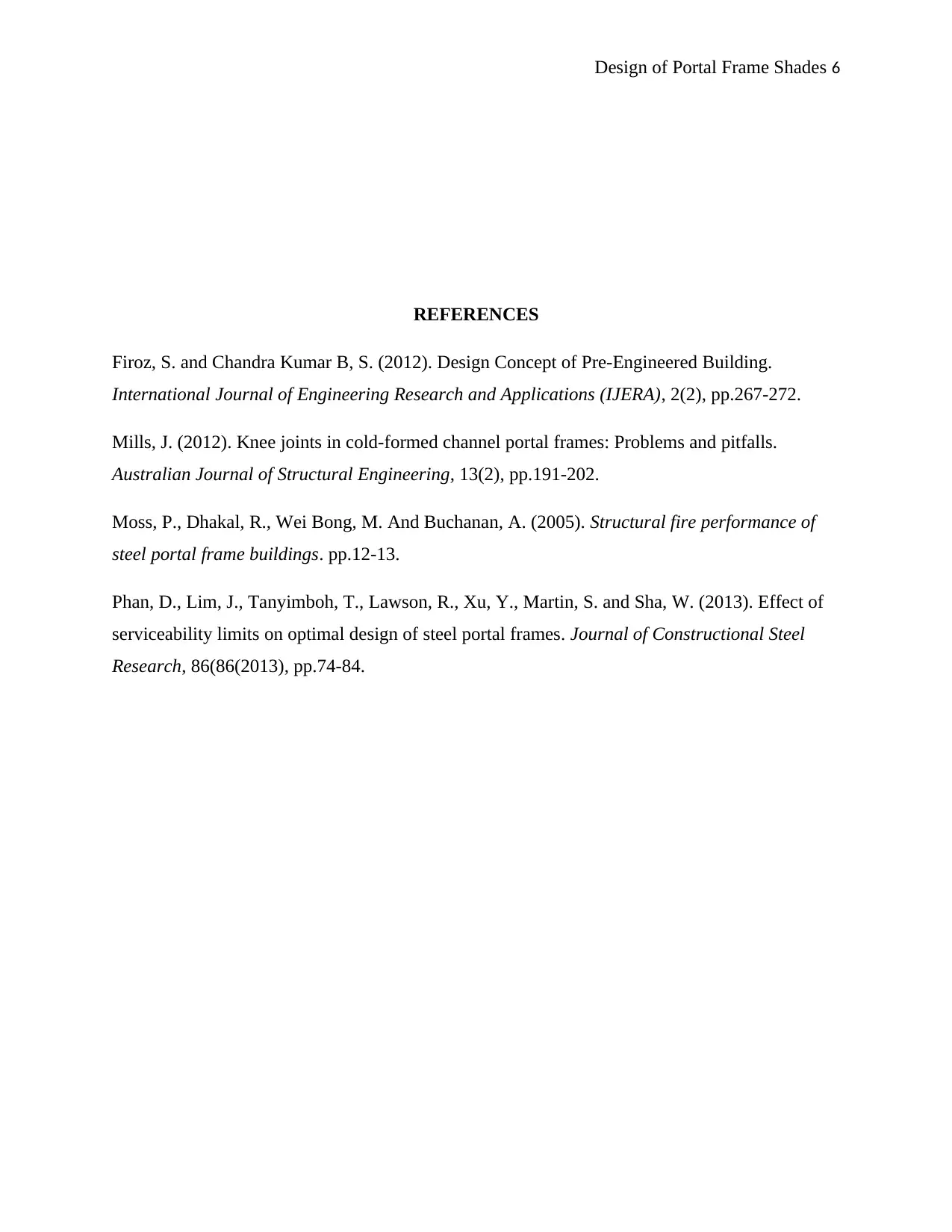
Design of Portal Frame Shades 6
REFERENCES
Firoz, S. and Chandra Kumar B, S. (2012). Design Concept of Pre-Engineered Building.
International Journal of Engineering Research and Applications (IJERA), 2(2), pp.267-272.
Mills, J. (2012). Knee joints in cold-formed channel portal frames: Problems and pitfalls.
Australian Journal of Structural Engineering, 13(2), pp.191-202.
Moss, P., Dhakal, R., Wei Bong, M. And Buchanan, A. (2005). Structural fire performance of
steel portal frame buildings. pp.12-13.
Phan, D., Lim, J., Tanyimboh, T., Lawson, R., Xu, Y., Martin, S. and Sha, W. (2013). Effect of
serviceability limits on optimal design of steel portal frames. Journal of Constructional Steel
Research, 86(86(2013), pp.74-84.
REFERENCES
Firoz, S. and Chandra Kumar B, S. (2012). Design Concept of Pre-Engineered Building.
International Journal of Engineering Research and Applications (IJERA), 2(2), pp.267-272.
Mills, J. (2012). Knee joints in cold-formed channel portal frames: Problems and pitfalls.
Australian Journal of Structural Engineering, 13(2), pp.191-202.
Moss, P., Dhakal, R., Wei Bong, M. And Buchanan, A. (2005). Structural fire performance of
steel portal frame buildings. pp.12-13.
Phan, D., Lim, J., Tanyimboh, T., Lawson, R., Xu, Y., Martin, S. and Sha, W. (2013). Effect of
serviceability limits on optimal design of steel portal frames. Journal of Constructional Steel
Research, 86(86(2013), pp.74-84.
⊘ This is a preview!⊘
Do you want full access?
Subscribe today to unlock all pages.

Trusted by 1+ million students worldwide
1 out of 6
Related Documents
Your All-in-One AI-Powered Toolkit for Academic Success.
+13062052269
info@desklib.com
Available 24*7 on WhatsApp / Email
![[object Object]](/_next/static/media/star-bottom.7253800d.svg)
Unlock your academic potential
Copyright © 2020–2025 A2Z Services. All Rights Reserved. Developed and managed by ZUCOL.




